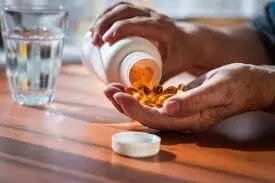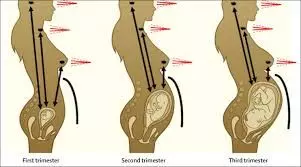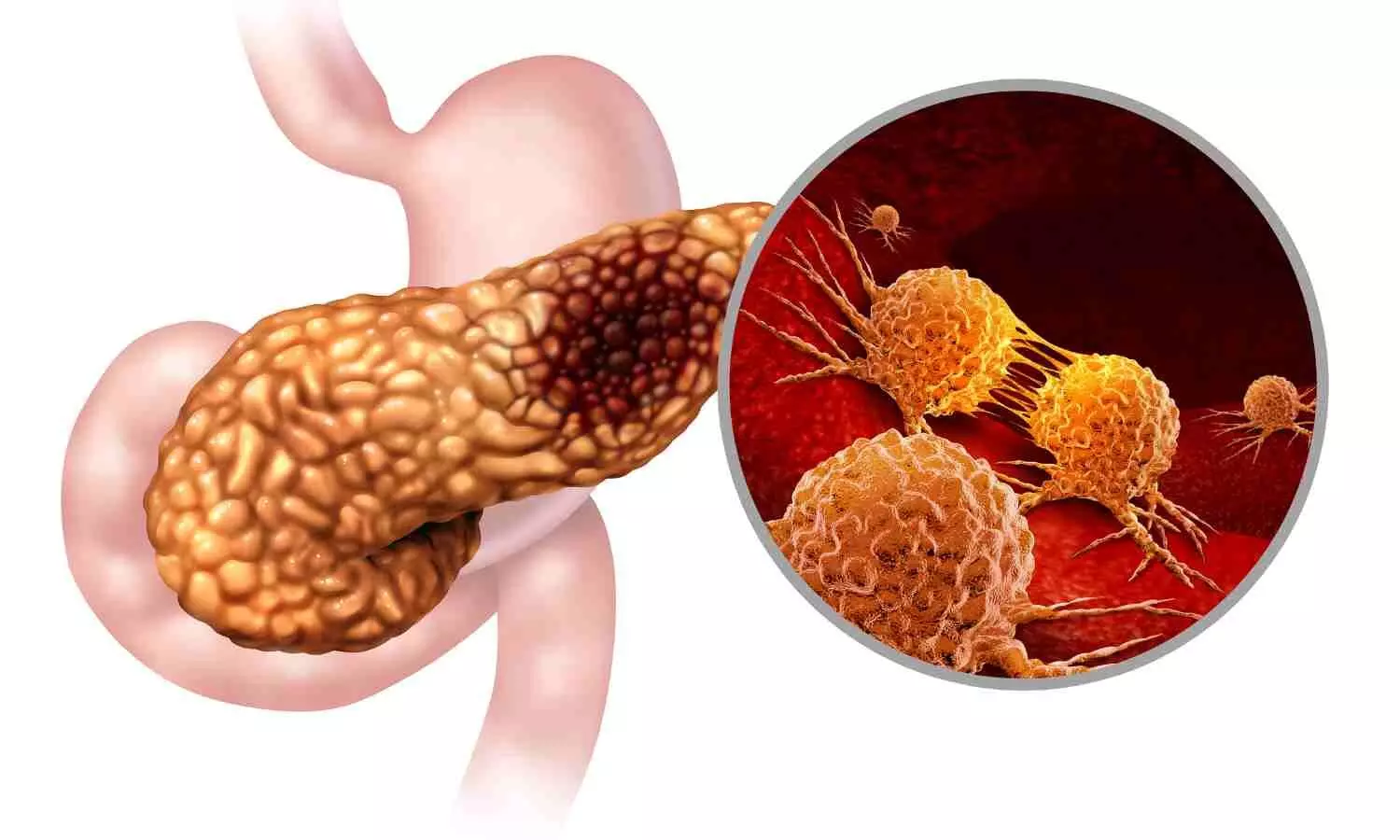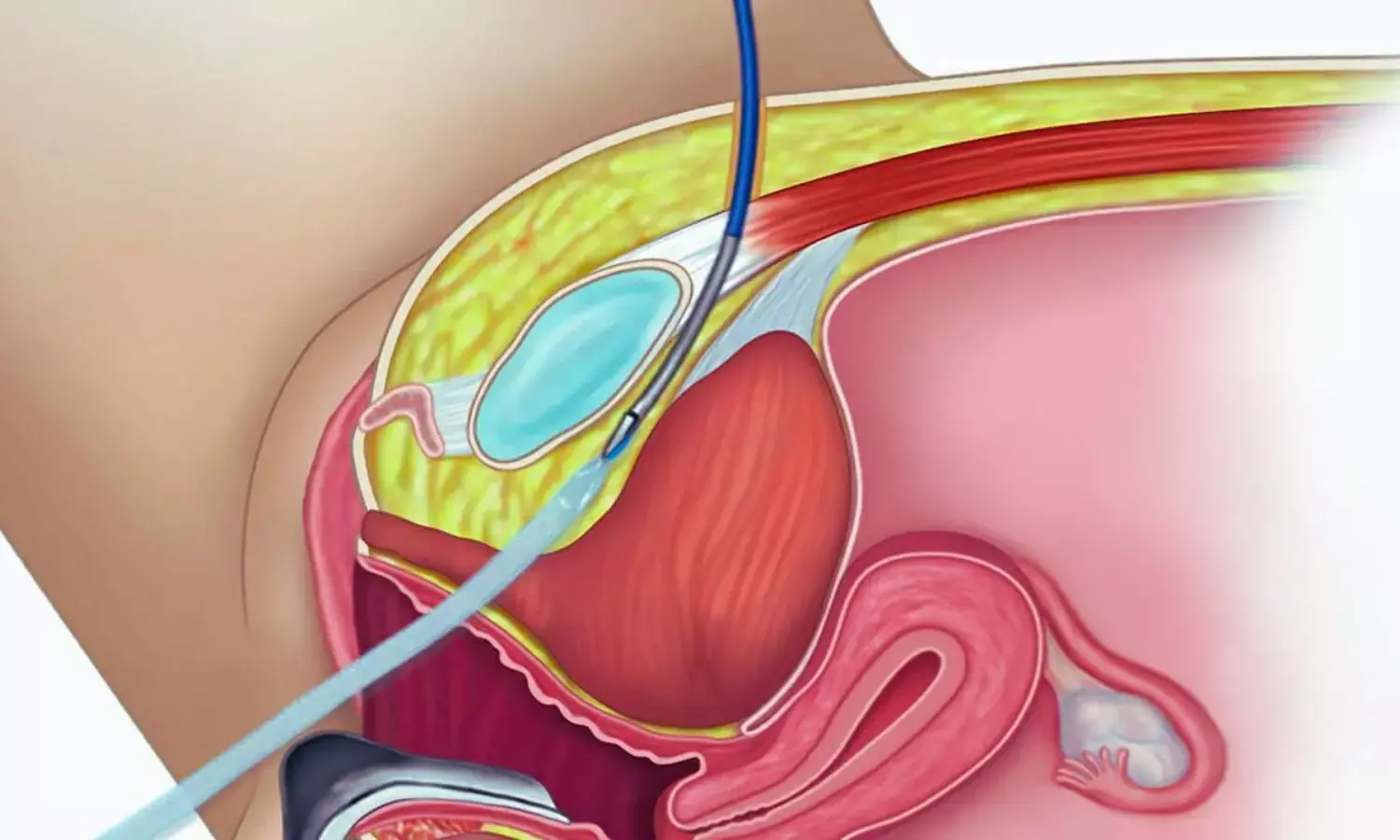Low-dose ketamine shows promise for pain relief in emergency department patients
Powered by WPeMatico
Powered by WPeMatico

Jaipur: Rajasthan Chief Minister Bhajanlal Sharma reiterated that the state government’s top priority is to ensure affordable, accessible, and quality healthcare for the people.
According to the PTI report, he instructed officials to ensure all the budgetary announcements related to the health sector should be completed at a fast pace with an effective action plan to realise the ‘Apno Swasth Rajasthan’ concept.
Sharma was chairing a review meeting of the Medical and Health Department in the Chief Minister’s Office on Tuesday.
Also Read:Govt to complete work on medical colleges on priority: Rajasthan CM Bhajanlal Sharma
Medical and Health Minister Gajendra Singh Khinvsar was also present in the meeting. He informed the chief minister that the process of recruitment on about 48,000 posts by the Medical and Health Department is going on at mission mode and so far appointment have been made on about 8000 posts.
Chief Minister Sharma said that to provide quality health services in small cities and towns, the state government has decided to build Ayushman Model CHCs across the state, news agency PTI reported.
The chief minister said that free treatment is being provided to the general public under the Chief Minister Ayushman Arogya Yojana.
The government has decided to include pediatric packages under this scheme and rationalise the rates of some packages. He instructed the officials to widely publicise the new provisions added to the scheme.
Medical Dialogues team had earlier reported that in a move to improve healthcare access for patients in remote areas, the state health department is set to launch hemodialysis services at 182 centres, including 11 district hospitals and 102 community health centres, within the next month. This initiative aims to bring much-needed relief to kidney failure patients who previously had to travel long distances for regular dialysis.
Also Read:Rajasthan officials to visit Delhi AIIMS to study Queue Management System
Powered by WPeMatico

Hyderabad: Based on crucial evidence gathered during an investigation, the Jagtial police arrested three accused from Jalandhar, Punjab, for their involvement in a trading fraud that defrauded a doctor of Rs 69 lakh.
According to the police, the three suspects in this case are members of a cybercriminal gang who allegedly cheated the doctor. Although the police managed to capture the trio, the main accused is absconding and a search is on to nab the accused.
The accused have been identified as Sumesh Kapoor, Rajeev Singh, and Jitender Kumar and the main accused name is Raju.
The incident took place after Kapoor who was a loan agent, two others were lured by another agent named Raju into the scam. The three accused opened a bank account in a fictitious construction firm’s name and supplied the account details to Raju.
Also read- SGPGI doctor’s mother put under digital arrest, loses Rs 18 lakh in 7 days
Using the firm’s fraudulent bank account, they lured the doctor into transferring Rs 24 lakh. Following this, they withdrew the amount and handed over the cash to Raju and, in turn, received 2 lakh cash as commission.
Speaking to TOI, a police officer said, “Kapoor was a loan agent, while the other two were working as sales managers at a poultry firm. Lured by another agent, Raju, Kapoor, with the help of the other two accused, opened a bank account in a fictitious construction firm’s name and supplied the account details to Raju. When the doctor fell into the trap, he transferred 24 lakh to Kapoor’s account. They withdrew the amount and handed over the cash to Raju and, in turn, received 2 lakh cash as commission. The three were brought to Jagtial on a transit warrant and remanded to judicial custody.”
The three accused were arrested after a police investigation into the payment details of the doctor when he transferred the amount to the fraudster’s account. This led to the tracing of bank accounts in Punjab, where the account holder was subsequently identified.
A special team was formed to investigate the case based on the doctor’s complaint. After two months of investigation, the team received a tip-off about their location and nabbed them a few days ago from Jalandhar. The team seized bank passbooks, debit cards, and other material from the trio. They were kept under judicial remand in Jagtial.
Police said, “The doctor has received a refund of 10 lakh and the remaining amount will be returned to him soon.”
Also read- AIIMS Jodhpur doctor duped of Rs 18 lakh by fake cardiologist on dating app
Powered by WPeMatico

A late-breaking clinical trial has shown that muvalaplin, an innovative oral medication, can safely and effectively lower elevated levels of lipoprotein (a), a key cardiovascular risk factor. These findings were presented at the American Heart Association’s Scientific Sessions 2024, held from November 16-18 in Chicago, a premier global event showcasing cutting-edge advancements in cardiovascular science.
The study, simultaneously published in JAMA: The Journal of the American Medical Association, highlights the potential of muvalaplin as a promising new therapy in cardiovascular care, addressing a significant unmet need for individuals with high lipoprotein (a) levels.
Lipoprotein(a), or Lp(a), is a type of inherited cholesterol level that is a common, independent risk factor for cardiovascular disease, affecting about 1 in 5 people worldwide. Black individuals of African descent and South Asian populations often have the highest Lp(a) levels, according to the American Heart Association’s 2021scientific statement “Lipoprotein(a): A Genetically Determined, Causal, and Prevalent Risk Factor for Atherosclerotic Cardiovascular Disease.” It is different from low-density lipoprotein (LDL), or “bad” cholesterol. Lp(a) numbers of 50 mg/dL (125 nmol/L) or higher promote clotting and inflammation, significantly increasing the risk of heart attack, stroke, aortic stenosis and peripheral artery disease, especially for people who also have cardiovascular disease or familial hypercholesterolemia.
There are several injectable medications undergoing clinical evaluation as treatments to lower Lp(a) levels. However, none have yet been approved by the U.S. Food and Drug Administration.
“Most medications being developed to lower Lp(a) are injectable. Muvalaplin is the first oral agent being developed to lower Lp(a) levels and acts by disrupting formation of the Lp(a) particle,” said study author Stephen Nicholls, MBBS, Ph.D., director of the Victorian Heart Institute at Monash University in Melbourne, Australia.
The KRAKEN clinical trial included 233 adults around the world who were identified at high risk of having a cardiovascular event due to very high Lp(a) levels (greater than 175 nmol/L). Researchers evaluated the effects of muvalaplin at different doses—10 mg, 60 mg or 240 mg, taken daily-compared with a daily placebo for 12 weeks. The researchers tested Lp(a) levels using both the traditional Lp(a) blood test and a new test that more specifically measures the levels of intact Lp(a) particles in the blood.
At week 12, the study found:
“We were encouraged by the degree of Lp(a)-lowering in these patients who are most likely to benefit from its use and by the safety and tolerability,” Nicholls said. “While muvalaplin appears to be an effective approach to lowering Lp(a) levels, we still need to study whether Lp(a) lowering will result in fewer heart attacks and strokes.”
The study had limitations, including that it was relatively small and trial participants were treated for only 12 weeks. “Larger, more diverse and longer-term studies are needed,” Nicholls noted.
Reference:
Stephen J. Nicholls et al, Oral Muvalaplin for Lowering of Lipoprotein(a): A Randomized Clinical Trial, JAMA (2024). DOI: 10.1001/jama.2024.24017
Powered by WPeMatico

Brazil: A recent study found that sedentary behavior (SB) is negatively associated with vascular health in postmenopausal women with rheumatoid arthritis (RA), and light physical activity (PA) is positively associated with vascular health.
The research, published online in the American Journal of Physiology: Heart and Circulatory Physiology, highlights the significant role that physical activity and reduced sedentary time can play in improving vascular function among individuals with RA.
Rheumatoid arthritis is a chronic autoimmune condition that affects the joints and increases the risk of cardiovascular disease. This heightened risk is partly due to systemic inflammation, which can damage blood vessels and lead to poor vascular health. Traditionally, treatment for RA focuses on controlling inflammation and managing joint symptoms, but there is growing recognition of the importance of improving cardiovascular health in these patients. While physical activity is widely recommended for managing cardiovascular health in RA, there is limited evidence on the specific relationships between objectively measured PA and vascular health markers in individuals with RA.
To fill this knowledge gap, T. Peçanha, Manchester Metropolitan University, Manchester, UK, and colleagues conducted a cross-sectional study involving 82 postmenopausal women with rheumatoid arthritis, averaging 62 ± 7 years. The participants underwent ultrasound assessments to evaluate vascular function and structure. These assessments included measurements of the brachial and superficial femoral artery (BA and SFA) flow-mediated dilation, baseline and post-hyperemia peak diameters, and carotid intima-media thickness, key indicators of vascular health.
Participants also completed a 7-day accelerometer-based assessment to measure physical activity and sedentary behavior. To examine the relationships between vascular health and PA outcomes, regression models were applied, adjusting for factors such as age, body mass index, and disease activity.
The regression analyses revealed the following key findings:
Sedentary Behavior:
Physical Activity:
Moderate-to-Vigorous PA:
“These findings suggest that reducing sedentary behavior and increasing light-intensity physical activity may positively impact vascular health in postmenopausal women with rheumatoid arthritis,” the researchers concluded.
Reference:
Meireles, K., Peçanha, T., Pinto, A. J., Santos, L. P., Mazzolani, B. C., Smaira, F. I., Rezende, D., M. Ribeiro, A. C., S. Pinto, A. L., Lima, F. R., D. Silva, J. N., Forjaz, L. M., Gualano, B., & Roschel, H. (2024). Improved vascular health linked to increased physical activity levels and reduced sedentary behavior in rheumatoid arthritis. American Journal of Physiology-Heart and Circulatory Physiology. https://doi.org/H-00640-2024
Powered by WPeMatico

USA: A new study from the Coronary Artery Risk Development in Young Adults (CARDIA) cohort has found that certain choline metabolites may be associated with an increased risk of developing type 2 diabetes over 15 years. The research, published in Diabetes Care, provides new insights into how the body processes choline, a nutrient commonly found in foods like eggs, liver, and soybeans, and its role in diabetes development.
According to the study, the findings align with existing research highlighting choline metabolism’s role in diabetes. However, the study expands on the current literature by examining a racially diverse, population-based cohort of early middle-aged adults, a group for whom preventive measures could be particularly impactful.
There has been growing interest in the potential role of choline metabolism in the development of diabetes. Most previous studies examining circulating choline metabolites and their link to diabetes risk have focused on older adults, often with a high prevalence of risk factors. Considering this, Katie A. Meyer, Nutrition Research Institute, University of North Carolina at Chapel Hill, Kannapolis, NC, and colleagues aimed to explore the association between choline metabolism and the risk of developing diabetes in a diverse cohort of early middle-aged adults, a population where preventive measures may be especially effective.
For this purpose, the researchers used data from year 15 of follow-up (2000-2001) in the CARDIA Study, which included 3,133 participants aged 33–45 years. Plasma levels of choline metabolites (choline, betaine, and trimethylamine N-oxide [TMAO]) were measured. The researchers quantified the associations between these metabolites and the 15-year risk of incident diabetes (n = 387) among participants who were free of diabetes at baseline.
Cox proportional hazards regression models were used to adjust for sociodemographic factors, health behaviors, and clinical variables in the analysis.
The findings of the study are as follows:
“Given existing literature and findings from the population-based study in early middle-aged adults, further research is needed to identify factors that may influence the link between plasma betaine and diabetes risk. Notably, the inverse association between betaine and diabetes risk in men but not women requires validation in larger samples. Additionally, studies like Mendelian randomization and larger trials are needed to assess causality and explore whether dietary modifications of betaine could reduce diabetes risk,” the researchers wrote.
“These results suggest that higher levels of circulating betaine may help reduce the risk of diabetes, potentially through the adoption of recommended healthy lifestyle changes,” they concluded.
Reference:
Jessica K. Sprinkles, Anju Lulla, Autumn G. Hullings, Isis Trujillo-Gonzalez, Kevin C. Klatt, David R. Jacobs, Ravi V. Shah, Venkatesh L. Murthy, Annie Green Howard, Penny Gordon-Larsen, Katie A. Meyer; Choline Metabolites and 15-Year Risk of Incident Diabetes in a Prospective Cohort of Adults: Coronary Artery Risk Development in Young Adults (CARDIA) Study. Diabetes Care 21 October 2024; 47 (11): 1985–1994. https://doi.org/10.2337/dc24-1033
Powered by WPeMatico

Vitamin D supplementation may lower BP in overweight elderly suggests a study published in the Journal of the Endocrine Society.
Supplementation with vitamin D and calcium can reduce systolic and diastolic blood pressure in older individuals with overweight, particularly in those with a body mass index (BMI) > 30 and those diagnosed with hypertension. Large cohort data have provided epidemiologic evidence linking vitamin D deficiency to a higher risk for cardiovascular disorders, including hypertension; however, evidence on the beneficial effects of vitamin D supplementation on blood pressure outcomes remains inconclusive. A post hoc analysis of a randomized controlled trial was conducted to investigate the effect of two doses of cholecalciferol (vitamin D3) on blood pressure in individuals aged 65 years or older with a BMI > 25 and serum vitamin D levels of 10-30 ng/mL. A total of 221 participants were recruited through outpatient departments, clinics, and advertisements in the greater Beirut area and received calcium supplementation in combination with either a low dose (600 IU/d, as recommended by the Institute of Medicine [IOM]) or a high dose (3750 IU/d) of vitamin D3. Blood pressure measurements were taken at baseline, 6 months, and 12 months using a SureSigns VS3 monitor. Participants were also stratified by BMI and hypertension status to assess the effects of vitamin D and calcium on blood pressure. Systolic and diastolic blood pressures were significantly reduced with vitamin D supplementation in the overall cohort (mean difference, 3.5 and 2.8 mm Hg, respectively; P = .005 and P = .002, respectively), with the effect more prominent in those in the high-dose vitamin D group. Participants with a BMI > 30 experienced reductions in both systolic and diastolic blood pressures in the overall cohort (P < .0001 and P = .01, respectively); although the systolic blood pressure was significantly reduced with both high- and low-dose vitamin D, the diastolic blood pressure decreased in the high-dose group only. Patients with hypertension benefited from all doses of vitamin D, regardless of the BMI. Systolic blood pressure at 6 and 12 months was significantly predicted by BMI and baseline systolic blood pressure measurements, although not by the dose of vitamin D received.
“The study found vitamin D supplementation may decrease blood pressure in specific subgroups such as older people, people with obesity, and possibly those with low vitamin D levels,” said study author, Ghada El-Hajj Fuleihan, MD, MPH, of the American University of Beirut Medical Center in Beirut, Lebanon, in a news release. “High vitamin D doses compared to the IOM’s recommended daily dose did not provide additional health benefits.”
Reference:
Maya Rahme, Laila Al-Shaar, Hani Tamim, Ghada El-Hajj Fuleihan, Blood Pressure Decreases in Overweight Elderly Individuals on Vitamin D: A Randomized Trial, Journal of the Endocrine Society, Volume 8, Issue 12, December 2024, bvae168, https://doi.org/10.1210/jendso/bvae168
Keywords:
Vitamin D, supplementation, lower BP, overweight, elderly, study, Journal of the Endocrine Society, Maya Rahme, Laila Al-Shaar, Hani Tamim, Ghada El-Hajj Fuleihan, Blood Pressure
Powered by WPeMatico

Chemotherapy during pregnancy is associated with increased morbidity and mortality among infants, reveals study published in the Journal of the National Cancer Institute.
Administration of chemotherapy during pregnancy is often delayed, while preterm delivery is common. If in utero exposure to chemotherapy is associated with adverse pediatric outcomes, it is unknown whether that relationship is directly attributable to the chemotherapy or is mediated by preterm birth. Cases were identified from Canadian cancer registries and administrative data in Alberta, British Columbia, and Ontario, 2003-2017, with follow-up until 2018. The primary exposure was receipt of chemotherapy during pregnancy. Severe neonatal morbidity and mortality (SNM-M), neurodevelopmental disorders and disabilities (NDDs) and pediatric complex chronic conditions (PCCC) reflected short- and long-term pediatric outcomes. Modified Poisson and Cox proportional hazard regression models generated adjusted risk ratios (RR) and hazard ratios (HR), respectively. The influence of preterm birth on the association between exposure to chemotherapy in pregnancy and each study outcome was explored using mediation analysis. Results: Of the 1150 incident cases of cancer during pregnancy, 142 (12.3%) received chemotherapy during pregnancy. Exposure to chemotherapy in pregnancy was associated with a higher risk of SNM-M (RR 1.67, 95% CI: 1.13-2.46), but not NDD (HR 0.93, 95% CI: 0.71-1.22) or PCCC (HR 0.96, 95% CI: 0.80-1.16). Preterm birth <34 and <37 weeks mediated 75.8% and 100% of the observed association between chemotherapy and SNM-M, respectively. Most children born to people with cancer during pregnancy appear to have favourable long-term outcomes, even following exposure to chemotherapy in pregnancy. However, preterm birth is quite common, and may contribute to increased rates of adverse neonatal outcomes.
Reference:
Amy Metcalfe, Zoe F Cairncross, Carly A McMorris, Christine M Friedenreich, Gregg Nelson, Parveen Bhatti, Deshayne B Fell, Sarka Lisonkova, Khokan C Sikdar, Lorraine Shack, Joel G Ray, Cancer chemotherapy in pregnancy and adverse pediatric outcomes: a population-based cohort study, JNCI: Journal of the National Cancer Institute, 2024;, djae273, https://doi.org/10.1093/jnci/djae273
Keywords:
Chemotherapy, during, pregnancy, associated, increased, morbidity, mortality, among, infants, reveals, Study , Amy Metcalfe, Zoe F Cairncross, Carly A McMorris, Christine M Friedenreich, Gregg Nelson, Parveen Bhatti, Deshayne B Fell, Sarka Lisonkova, Khokan C Sikdar, Lorraine Shack, Joel G Ray, Cancer, Journal of the National Cancer Institute, Cancer, oncology, pregnancy, toxicity, neonate, pediatric, mediation analysis, risk
Powered by WPeMatico

Results from a randomized phase 2 clinical trial show that adding high-dose, intravenous (IV) vitamin C to chemotherapy doubles the overall survival of patients with late-stage metastatic pancreatic cancer from eight months to 16 months.
“This is a deadly disease with very poor outcomes for patients. The median survival is eight months with treatment, probably less without treatment, and the five-year survival is tiny,” says Joe Cullen, MD, University of Iowa professor of surgery, and radiation oncology, and senior author of the study. “When we started the trial, we thought it would be a success if we got to 12 months survival, but we doubled overall survival to 16 months. The results were so strong in showing the benefit of this therapy for patient survival that we were able to stop the trial early.”
The findings, published in the November issue of Redox Biology, mark another success for high-dose, intravenous vitamin C, which has overcome many hurdles in the almost 20 years UI researchers have persevered to demonstrate its benefit for cancer patients.
“We’ve had ups and downs, of course, but this is a culmination of a lot of people’s hard work,” says Cullen, who also is a member of UI Health Care Holden Comprehensive Cancer Center. “It’s really a positive thing for patients and for the University of Iowa.”
In the study, 34 patients with stage 4 metastatic pancreatic cancer were randomized to receive either standard chemotherapy (gemcitabine and nab-paclitaxel), or the chemotherapy plus infusions of high-dose vitamin C. The results showed that average overall survival was 16 months for the patients receiving the chemotherapy plus vitamin C, compared to eight months for the patients getting just chemotherapy. In addition, progression-free survival was extended from four months to six months.
“Not only does it increase overall survival, but the patients seem to feel better with the treatment,” Cullen says. “They have less side effects, and appear to be able to tolerate more treatment, and we’ve seen that in other trials, too.”
The new study is not the only evidence of the benefit of including IV vitamin C as part of cancer treatment. Earlier this year, the results of another UI phase 2 clinical trial in patients with glioblastoma, a deadly form of brain cancer, were published. That study also showed a significant increase in survival when high-dose, IV vitamin C was added to standard of care chemotherapy and radiation. Cullen was also part of that trial along with his colleague Bryan Allen, MD, PhD, UI professor and head of radiation oncology.
A third phase 2 trial in non-small cell lung cancer is still underway, with results expected within the year. All three trials were funded by a grant from the National Cancer Institute (NCI).
“This NCI funding was incredibly important for us to conduct these phase 2 trials and obtain these really encouraging results. Our aim is to show that adding high-dose, IV vitamin C, which is very inexpensive and very well tolerated, can improve treatment for these cancers that are among the deadliest affecting the U.S. population,” Cullen adds.
Cullen, Allen, and their colleagues at UI Health Care have been researching the anti-cancer effect of high-dose, IV vitamin C for decades. Their work revealed a critical difference between vitamin C given intravenously and vitamin C taken orally. Giving vitamin C through an IV produces very high levels in the blood, which cannot be achieved with oral delivery. These high concentrations result in unique chemical reactions within cancer cells that render the cells more vulnerable to chemo- and radiation therapies.
Cullen notes that despite skepticism towards vitamin C as a cancer therapy, the results he and his colleagues have obtained, from basic science findings to understand the biological mechanisms at work, through the various clinical trials, have been highly encouraging and robust.
“Through every step of the process, it continued to improve. We did it in cells, it worked great. We did it in mice, it worked great. Then our phase one trials looked very promising. So, the progression has just been phenomenal, really,” Cullen says. “For example, in one of our phase 1 trials for pancreatic cancer, where we combine high-dose IV vitamin C with radiation, we still have three long-term survivors. They’re out nine years at this point, which is far beyond the typical survival range.”
Reference:
Kellie L. Bodeker, Brian J. Smith, Daniel J. Berg, Chandrikha Chandrasekharan, Saima Sharif, Naomi Fei, Sandy Vollstedt, Heather Brown, Meghan Chandler, Amanda Lorack, Stacy McMichael, Jared Wulfekuhle, Brett A. Wagner, Garry R. Buettner, Bryan G. Allen, Joseph M. Caster, Barbara Dion, Mandana Kamgar, John M. Buatti, Joseph J. Cullen,A randomized trial of pharmacological ascorbate, gemcitabine, and nab-paclitaxel for metastatic pancreatic cancer, Redox Biology, https://doi.org/10.1016/j.redox.2024.103375.
Powered by WPeMatico

Norway: A recent study has raised important questions about the effectiveness and safety of shorter slings used to treat urinary incontinence, a common condition affecting many individuals, particularly women. The study compared shorter sling procedures, designed to treat stress urinary incontinence (SUI), with longer sling techniques, focusing on continence outcomes and safety profiles over 6-12 months.
The findings, published in the International Urogynecology Journal revealed that shorter slings lead to worse continence outcomes, both subjectively and objectively, over 6-12 months, but are associated with fewer complications overall, except for longer-lasting postoperative pain.
Traditional slings, such as tension-free vaginal tape (TVT) and tension-free vaginal tape obturator inside-out (TVT-O), are known for their reliable continence outcomes but can lead to serious complications. To address this, Kjersti Rimstad, Faculty of Medicine, University of Oslo, Oslo, Norway, and colleagues aimed to assess whether slings with less synthetic material, namely Ajust and TVT-O Abbrevo (TVT-A), have similar failure and complication rates over 6 to 12 months, including the risk of prolonged postoperative pain, when compared to traditional slings.
For this purpose, the researchers conducted a registry study using data from the Norwegian Female Incontinence Registry (NFIR), which included 611 patients who received Ajust, 2,772 who received TVT-O Abbrevo (TVT-A), and 18,612 who had traditional slings. The study utilized preoperative, surgical, and 6–12-month follow-up data collected between 2009 and 2021.
Objective failure was defined as ≥1 g of leakage on a standardized cough-jump stress test, while subjective failure was defined as a stress index score ≥3 on a validated questionnaire. Prolonged postoperative pain was defined as pain lasting more than 3 months.
The following were the key findings of the study:
The findings showed that all types of slings investigated showed good continence outcomes, both subjectively and objectively, with low failure rates after 6–12 months. While the shorter slings demonstrated slightly higher failure rates, the differences were minimal and unlikely to have a significant clinical impact.
Despite the slightly reduced effectiveness of shorter slings, they appeared to result in fewer overall complications. However, the Ajust™ sling was associated with higher rates of new-onset urgency incontinence, and the TVT-A sling had higher rates of prolonged postoperative pain. When comparing the two traditional slings, the TVT had the highest complication rate, while the TVT-O was more comparable to the shorter slings concerning complications.
“The study suggests that there is no definitive “best” sling for surgery, and the choice between a traditional or shorter sling should be based on careful discussion between the patient and doctor, considering both effectiveness and potential risks,” the researchers concluded. “The findings also highlight that the incidence of prolonged postoperative pain is low across all slings, a point that should be communicated to health authorities given ongoing concerns about the future use of synthetic slings for stress urinary incontinence. Further studies are needed to better understand the long-term outcomes and rates of postoperative pain associated with different sling types.”
Reference:
Rimstad, K., Oversand, S.H., Engh, M.E. et al. Effectiveness and Safety of Shorter Incontinence Slings. Int Urogynecol J (2024). https://doi.org/10.1007/s00192-024-05971-5
Powered by WPeMatico
